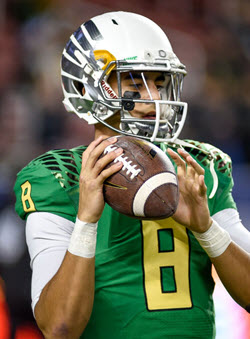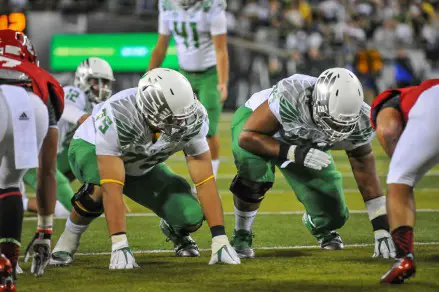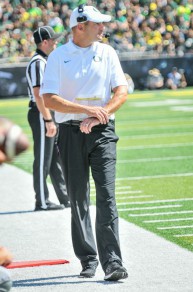The 2014 college football season has marked a significant turning point in the sport’s history. The playoff committee altered the criteria for greatness and forever changed the way fans and analysts watch football games.
A blank loss column is no longer enough to stay atop the national rankings, something we learned from the committee’s treatment of an undefeated Florida State team. You need to win with style against strong opponents and look good doing it.
At this point in the season, most would argue that not one team has truly separated itself as the clear-cut leader. Instead, we have had two one-loss teams in Alabama and Oregon leading a shaky but unbeaten Seminoles squad, and now another one-loss team, TCU, slipping ahead of the Seminoles.

Marcus Mariota in 2014.
Perhaps because of this lack of separation by a single team, the theme of this 2014 season seems to be “overcoming adversity.” This is true on every scale, whether it comes in the form of one-loss teams like Oregon and Alabama trying to come back from early-season losses, or Florida State recovering in the second half to correct first-half mistakes and outlast opponents.
The ability to overcome adversity has proven to be extremely attractive to both the general media and the committee, which is perhaps why Jameis Winston is still viewed as one of the best quarterbacks in college football despite his 21-17 touchdown to interception ratio.
Adversity has also come in the form of injuries. While every team struggles with injuries, it seems hard to believe (perhaps with the exception of Ohio State) that any team has had more issues in this area than Oregon, at least in terms of quantity. Before the season even began, the Ducks had already lost starting left tackle Tyler Johnstone and the team’s leading returning receiver Bralon Addison.
Since then, Thomas Tyner, Jake Fisher, Andre Yruretagoyena, Hroniss Grasu, Keanon Lowe, Pharaoh Brown, and Arik Armstead have all experienced varying degrees of injury. Of these nine total players listed, seven were penciled in to be starters before the season began, and Tyner gets enough work to have the same impact.
The perfect storm occurred toward the end of September when Oregon’s top three offensive tackles in Johnstone, Fisher, and Yruretagoyena were all sidelined. The Ducks gave up a combined 12 sacks to Washington State and Arizona in that span, and eventually fell to the Wildcats.
Not to make excuses for the Ducks, but with that in mind, Oregon’s loss can at least partially be attributed to those significant injuries while Alabama largely beat itself with turnovers, drops, and negative plays against Ole Miss (though it should be noted that Tide players Kenyan Drake and Ryan Kelly both suffered injuries during that game).
Using the same reasoning, Florida State’s “adversity” usually comes in the form of its own mistakes, most notably Winston’s 13 first-half interceptions.
Despite all of the injuries and the early loss that came with it, Oregon receives little credit for overcoming adversity. This, ironically, is largely due to the team’s consistent dominance since the loss. Aside from the Washington State and Arizona games, the Ducks have been outscoring their opponents 48.9 to 21.7, giving them an average margin of victory of 27.2!
In the seven-game stretch since getting Fisher back at left tackle, Oregon has defeated ranked UCLA and Utah teams on the road and posted 45 points on Stanford’s elite defense.
In that same stretch, Alabama was two dropped interceptions away from being shut out by Arkansas, and would have likely fallen to LSU if not for a costly kickoff out of bounds by the then-leading Tigers to give the Tide great field position with under a minute to play.
To put it into perspective, for Oregon that 27.2 margin of victory with Fisher back is higher than every team that has made it to a national championship game since 2010 except for Florida State last year (39.5) and Alabama in 2012 (27.8). In other words, the 2014 Ducks when even semi-healthy, are nearly as dominant as any team has been over the last 5 years.
And what about this season? Even when the Arizona and Washington State games are included, Oregon’s 22.6 average margin of victory easily exceeds that of Florida State (12.6) and Alabama (19.8).
Despite Alabama being in the SEC, Oregon clearly has the stronger schedule as well. Based on last week’s college football playoff rankings, the Ducks are 3-1 against ranked teams while Alabama is 2-1, with both of those wins at home. In fact, with the exception of Mississippi State, every team that the Tide has defeated has at least four losses on the season.
Oregon has been so consistently dominant since its loss that, despite moving back up in the rankings, no one seems to be talking about it. As Charles Fischer pointed out, the Ducks were mentioned only twice during last week’s College Football Playoff show.
This holds true on a smaller scale as well. Quarterback Marcus Mariota has moved the ball at will against every team he has played, including in the loss to Arizona where he threw for 276 yards with three total touchdowns.
Over the past seven years, only Russell Wilson in 2011 had a higher passer rating (191.78) than Mariota’s current number (190.2). That includes five Heisman trophy winners and three No.1 overall NFL draft selections.
At this point last season, Winston had posted 3,624 total yards and 38 total touchdowns and had only played against one team (Clemson) that finished in the Top 25. In his first 12 games in 2014, Mariota has played four currently ranked teams (plus an additional Top 5 defense in Stanford) and recorded 4,106 total yards and 47 total touchdowns.
However, it is that consistent dominance that seems to be the strongest case against him in terms of the Heisman Trophy. Many claim he has not had his “Heisman Moment” while Melvin Gordon’s 408-yard game against Wisconsin has catapulted him up the rankings. In this argument, a certain shovel pass and subsequent comeback against Michigan State are conveniently ignored.
Others claim that he only throws to wide-open receivers due to the team’s offensive system. While this is sometimes the case and is a concept that holds true on paper, it does not translate into reality nearly as much as many seem to think.
Even if that were true, Mariota can make all the throws, and it is the threat of his speed, his vision and eye deception, and his decision-making that creates so much space for his receivers in the first place. If using Oregon’s offensive system guaranteed open receivers and 45 points per game, then every coach that isn’t Mark Helrich would be fired for not using it.
Overcoming adversity has become such a strong theme in 2014 that Mariota and Oregon are practically being forgotten because of how consistently dominant they’ve been. This is not necessarily a bad thing, and a No. 2 ranking is nothing to complain about.
Still, Alabama has jumped the Ducks in the rankings despite a smaller average margin of victory and an inferior schedule, Gordon is considered by many to be catching Mariota in the Heisman race, and Winston is still considered by some to be the best quarterback around.
These other top-tier teams and players certainly deserve respect and praise for what they have accomplished. Nonetheless, history shows that what Mariota and Oregon have done in 2014 is as special as anything we’ve seen in college football, and it needs to be appreciated as such.
Top Photo by Kevin Cline
Joey Holland graduated from the University of Oregon in 2013, majoring in History. He played several sports in high school, though football remains his passion. He has yet to miss a single Oregon Ducks home football game during his time in Eugene. Joey has written previously for Bleacher Report and Football Nation.
Joey welcomes your feedback.




